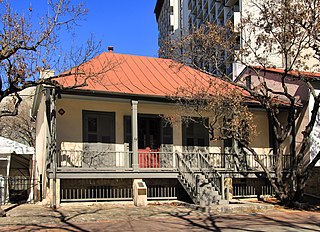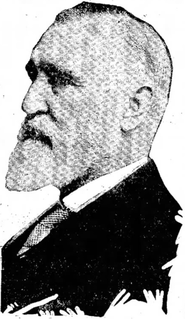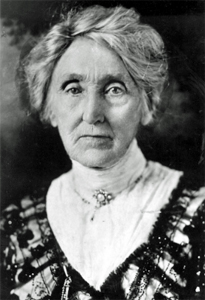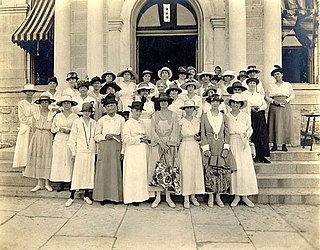
St. Mary's University is a private Marianist liberal arts institution in San Antonio, Texas. Founded by the Society of Mary (Marianists) in 1852, St. Mary's is the oldest Catholic university in Texas and the American Southwest. With a student population of nearly 4,000, St. Mary's is home to a College of Arts, Humanities and Social Sciences; School of Science, Engineering and Technology; the Greehey School of Business; and the St. Mary's University School of Law.

Bexar County is a county in the U.S. state of Texas. As of the 2010 census, the population was 1,714,773, and a 2019 estimate put the population at 2,003,554. It is the 16th-most populous county in the nation and the fourth-most populated in Texas. Its county seat is San Antonio, the second-most populous city in Texas and the seventh-largest city in the United States.

The Daughters of the Republic of Texas (DRT) is a lineal association dedicated to perpetuating the memory of the founding families and soldiers of the Republic of Texas. The Daughters of the Republic of Texas is best known for its former role as caretakers of The Alamo. In early 2015, Texas Land Commissioner George P. Bush officially removed control of the Alamo to the Texas General Land Office. The DRT are also the custodians of the historic French Legation Museum owned by the State of Texas. In addition, they operate a museum in Austin on the history of Texas.
José Ángel Navarro (1784–1836), known as José Ángel Navarro, was born in San Antonio de Béxar and became a soldier under Spanish Texas. He was the son of Ángel Navarro, a brother to Texas statesman José Antonio Navarro, and an uncle to Texas legislator José Ángel Navarro III.

Carlos Bee was an attorney and politician, serving as U.S. Representative from Texas. He was a son of Hamilton P. Bee and a great-grandson of Thomas Bee, a politician and judge in South Carolina in the Revolutionary and Federal periods.
Atlee Bernard Ayres was an American architect. He lived in central Texas.

The Guenther House is a restaurant, museum and store located at 205 E. Guenther Street in the King William neighborhood of the Bexar County city of San Antonio in the U.S. state of Texas. Currently operated by C. H. Guenther and Son. Inc., the home was originally built as a private residence in 1859 by Pioneer Flour Mills founder Carl Hilmar Guenther. It was listed on the National Register of Historic Places listings in Bexar County, Texas on October 11, 1990.

The Conservation Society of San Antonio is located in the Bexar County city of San Antonio in the U.S. state of Texas. Founding members were Emily Edwards, who became the organization's first president, and Rena Maverick Green. The organization was formed on March 22, 1924, and officially incorporated on July 8, 1925. The Society is currently headquartered in the Anton Wulff House, which they saved from destruction in 1974. The home was built 1869–1870 by German immigrant Anton Wulff, who became the city's first Park Commissioner.

The Edward Steves Homestead is located in the Bexar County city of San Antonio in the U.S. state of Texas. It was designed by architect Alfred Giles and designated a Recorded Texas Historic Landmark. The main house was donated to the San Antonio Conservation Society in 1952. The organization completely restored the main house as a museum and now conducts daily tours. The complete homestead property consists of four individual structures: the main house museum, the carriage house, the river house, and the servants' quarters. It is listed on the National Register of Historic Places listings in Bexar County, Texas, as a contributing structure of the King William Historic District.

The Jeremiah Dashiell House is located in the Bexar County city of San Antonio in the U.S. state of Texas. Also known as Casa Villita, it was designated a Recorded Texas Historic Landmark under that name in 1962. It is listed on the National Register of Historic Places listings in Bexar County, Texas as a contributing structure of the La Villita Historic District.

The Anton Wulff House is located in the Bexar County city of San Antonio in the U.S. state of Texas. It was designated a Recorded Texas Historic Landmark in 1976. It is listed on the National Register of Historic Places listings in Bexar County, Texas as a contributing structure of the King William Historic District. The house has been the headquarters of the San Antonio Conservation Society since 1975. German immigrant businessman Wulff was a city alderman, San Antonio's first park commissioner, and the man who designed the layout and beautification of Alamo Plaza.

The Yturri–Edmunds Historic Site is a historic site in San Antonio, Texas. The house is listed on the National Register of Historic Places listings in Bexar County, Texas. The homestead and mill were designated a Recorded Texas Historic Landmark in 1966.

Acequia Madre de Valero is an 18th-century agricultural irrigation canal built by the Spanish and located in the Bexar County city of San Antonio in the U.S. state of Texas. When Martín de Alarcón founded San Antonio for Spain by establishing San Antonio de Valero Mission in 1718, Franciscan priest Antonio de Olivares and the Payaya people dug Acequia Madre de Valero by hand. It was vital to the missions to be able to divert and control water from the San Antonio River, in order to grow crops and to supply water to the people in the area. This particular acequia was the beginning of a much wider acequia system. Acequia Madre de Valero ran from the area currently known as Brackenridge Park and southward to what is now Hemisfair Plaza and South Alamo Street. Part of it that is not viewable by the public runs beneath the Menger Hotel. The acequia was restored in 1968 and that year was designated a Recorded Texas Historic Landmark.

George Washington Brackenridge was a philanthropist and the longest-serving Regent for the University of Texas. His donations of time, land holdings and wealth expanded the university and provided educational opportunities for women and other minorities. He was an advocate of women's suffrage and women's educational opportunities. He was also a business man who made his initial wealth as a profiteer during the Civil War. Brackenridge organized two banking institutions in San Antonio and served as their president. He was president of the San Antonio Water Works Company. Alamo Heights in Bexar County was once his residence and was named by him. His mansion Fernridge is now part of University of the Incarnate Word campus. Brackenridge Park, San Antonio Japanese Tea Garden and Mahncke Park in San Antonio were made possible through his donations of land holdings.

Mary Eleanor Brackenridge was one of three women on the first board of regents at Texas Woman's University, the first women in the state of Texas to sit on a governing board of any university. She was active in women's clubs and was a co-founder of the Woman's Club of San Antonio. Brackenridge was a leader in Texas suffrage organizations and helped get the 19th Amendment to the United States Constitution passed. She was the first woman in San Antonio to register to vote. Although it's the Brackenridge name in Texas that is associated with wealth, philanthropy and achievement, Brackenridge qualified as a member of the Daughters of the American Revolution through her mother's lineage. Miss Brackenridge was a founding member and the first Regent of the oldest DAR chapter in San Antonio, the San Antonio de Bexar Chapter, NSDAR, established on December 11, 1902.

The David J. and May Bock Woodward House is located in the Alta Vista district of the Bexar County city of San Antonio in the U.S. state of Texas. It was designated a Recorded Texas Historic Landmark in 1994. It was placed on the National Register of Historic Places listings in Bexar County, Texas on February 16, 1996.

The following is a timeline of the history of the city of San Antonio, Texas, United States.

The Texas Equal Suffrage Association (TESA) was an organization founded in 1903 to support white women's suffrage in Texas. It was originally formed under the name of the Texas Woman Suffrage Association (TWSA) and later renamed in 1916. TESA did allow men to join. TESA did not allow black women as members, because at the time to do so would have been "political suicide." The El Paso Colored Woman's Club applied for TESA membership in 1918, but the issue was deflected and ended up going nowhere. TESA focused most of their efforts on securing the passage of the federal amendment for women's right to vote. The organization also became the state chapter of the National American Woman Suffrage Association (NAWSA). After women earned the right to vote, TESA reformed as the Texas League of Women Voters.

This is a timeline of women's suffrage in Texas. Women's suffrage was brought up in Texas at the first state constitutional convention, which began in 1868. However, there was a lack of support for the proposal at the time to enfranchise women. Women continued to fight for the right to vote in the state. In 1918, women gained the right to vote in Texas primary elections. The Texas legislature ratified the 19th amendment on June 29, 1919, becoming the ninth state and the first Southern state to ratify the amendment. While white women had secured the vote, Black women still struggled to vote in Texas. In 1944, white primaries were declared unconstitutional. Poll taxes were outlawed in 1964 and the Voting Rights Act was passed in 1965, fully enfranchising Black women voters.
















